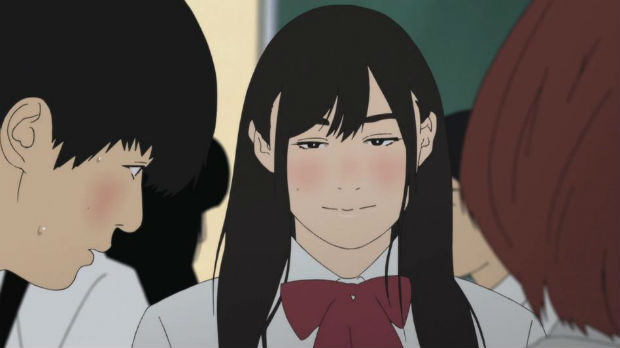This is a very black or white series. You will either love it or hate it, but you will never be uncertain about it.
“Flowers of Evil” (or, as they call it, “Aku No Hana”) is doing things I rarely see in animation and I have never seen in anime. First, it is rotoscoped. For those who do not know what that is, you film live action, then animate it. “Through a Glass Darkly” was the last time you may have seen it (or not; it was a stinky film). What this means is that you have a more natural look, but the movements may come off as stiff or stilted, as you are not employing squash-and-stretch techniques of normal animation.
Second, because of the more natural look, standard anime tropes are gone. With the exception of one fantasy sequence, there is no turning to stone and crumbling away or sliding into chibi style or anger bars flashing at one’s forehead when things go wrong.
Third, the more natural look means the world is dirty and grimy and depressing, so there are chipped concrete blocks and cracked roads and torn posters and rusting signs and stained walls and weed growth. Certainly not crisp and clean, no caffeine, as you see in even the most action-adventure animes.
Fourth, everyone looks Japanese. I mean, I have seen a ton of anime and this is a rare moment for me where people look Japanese. This also has to be the sweatiest series I have seen. People are awash in their perspiration. Perhaps you could use this as a basis for an Old Spice commercial (“If we can help THIS guy, you are a piece of cake. Or Boston Cream Pie. I like Boston Cream Pie.”)
Now, to the story: our drenched anti-hero to the left is Takao Kasuga. He is both painfully shy and extremely introverted. He is constantly reading Charles Baudelaire’s “Les Fleurs de Mal” (“The Flowers of Evil”, for those who took Spanish in high school and not French). This book of poetry was important in the symbolist and modernist movements. The subject matter of these poems dealt with themes relating to decadence and eroticism, (if you fell asleep in English class and missed it). Now, he has a crush on Nanako Saeki (the other face you see), but lacks both the courage and commitment to tell her of his feelings for her.
One day, he has to go back to school after class to grab his book he left behind, only to find the bag of Saeki’s gym clothes falling out of a cubby. Impulsively, he takes it, only to have been seen by Sawa Nakamura (the back of the head on the right). She blackmails him into a contract to try and break down his walls and escape this decaying town. Now, everything Saeki is (pretty, smart, popular, energetic) Nakamura is not and this fuels her angst. The series looks at this bizarre love triangle and how they are destructive to themselves and each other, allowing these ‘flowers of evil’ to blossom.
This is a psychological drama, so the story unfolds slowly, perhaps too slowly for some, and Kasuga is such a door mat, that he allows himself to be stripped naked TWICE by Nakamura. The language is bracing, something far different from the run of anime you have watched and, as I said, you may not like how it unfolds, as Nakamura pushes and shoves and prods and goads and is a real instigator to the point of her being possibly psychotic.
I had a question about the artwork, in that in some instances, you do not see their faces. You see a head, but no details. I wondered if it was a business decision (they could not anime it as best as they wanted, so avoided it) or an artistic decision (these people are rather faceless and non-descript). You also ponder the relationship between Kasuga and Nakamura. Does she push as hard as she does to make him ‘man up’, or is she reveling in her power and authority over this bowl of porridge, as she has none in her regular life?
One spoiler that I will deliver right now is that they get to Episode 13 and….CONTINUE IT! I was hoping for a resolution, but it looks like that has to wait for another season to conclude this tale. I was drawn in as it was different, both in approach and display. There were times that things did not make sense, but things are like that in life. However, this is not a series that you can ‘kind of’ watch; it does require a lot of concentration and commitment, as there is a lot going on with this tale. It also unfolds like a manga, as there are long shots on buildings or they are standing in the rain, as we are going for mood. I am going to suggest that you at least watch the first two episodes and judge from there, but, please, avail yourself of it.
On a scale of 1 to 10:
Artwork 7 (It’s still rotoscoping)
Plot 9 (A good plot)
Pacing 7 (Very slow, almost turtle-like)
Effectiveness 7 (Tied to the continuance)
Conclusion 2 (We got a horrible coupler point)
Fan Service 0 (A similar show would be “Honey and Clover”)
Overall 7 (The ending cheat)
And remember, it’s first run until you’ve seen it. How sweaty does he get?

Leave a Reply